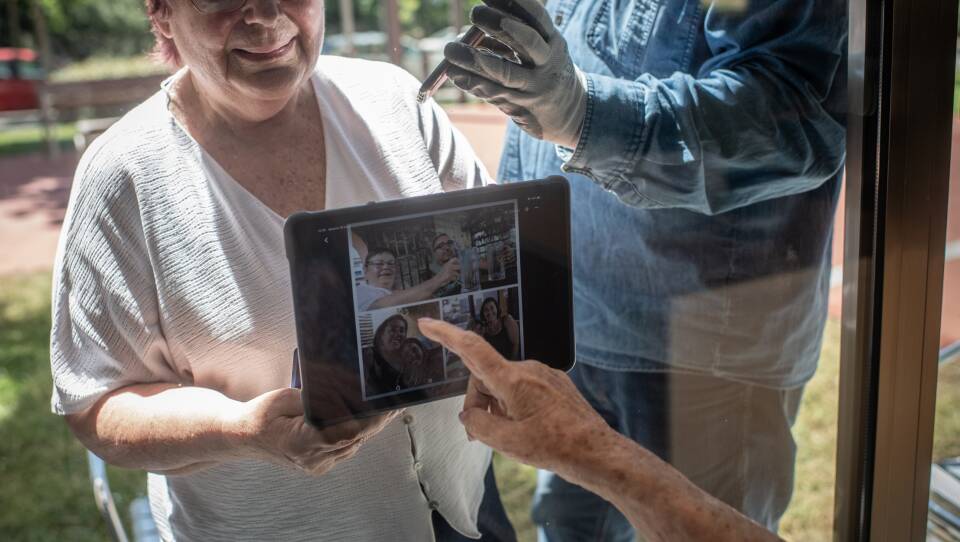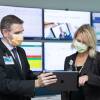The Blue Ledge Co-op sits just off Washington Street in Boston’s Roslindale neighborhood, nestled among trees and just a short walk from Stony Brook Park. The 80-unit building is owned and managed by CSI Support & Development Services, a non-profit affordable housing developer with properties in Massachusetts and around the country. Blue Ledge is a diverse community, and home to more than 80 seniors.
Over the past year, COVID-19 intensified preexisting challenges for the residents and staff at Blue Ledge. The virus is especially affecting the aging population, people from low-income communities and those from different demographic backgrounds, who have long experienced inequality, social injustice and more negative health outcomes. For residents of Blue Ledge, the physical danger posed by the virus was compounded by increased social isolation and the challenges many residents faced as more and more critical services moved online.
For Judith and Tatiana, who lead health and wellness services at Blue Ledge, there was an urgent need to connect safely with residents and ensure they had the support necessary to manage day-to-day tasks, connect with loved ones, participate in spiritual life and — critically — access health care.
Since 2018, Blue Ledge has partnered with Tech Goes Home to provide residents with iPads or laptops, affordable internet and culturally competent digital training — helping them develop the skills and confidence to more easily and effectively use digital tools. So, when the pandemic started, Judith and Tatiana were able to lean on that existing infrastructure and refocus the training and digital resources to address the critical health needs of their community.
Blue Ledge residents learned how to use Zoom to connect with primary care physicians and manage chronic conditions — minimizing the need for potentially dangerous, in-person visits; they gained access to virtual programming aimed at maintaining physical health and interpersonal connection; they were able to have bible study, attend online religious services, funerals, and weddings, combatting social isolation and loneliness; and many learned how to find health information online, manage prescriptions, and more.
Digital tools have provided a critical link for Blue Ledge residents — with one another, with staff, with loved ones, and with health care providers. Blue Ledge’s experience shows the potential positive impact that expanded digital access can have on health outcomes for at-risk communities. On the flip side, it is a reminder of how much is being lost for the millions of people, in Massachusetts and across the country, who don’t have the digital tools to better support their physical, mental, and emotional health.
While the expansion of digital healthcare — which has accelerated during the pandemic — theoretically promises to expand access to care among previously underserved communities, without an intentional focus on affordable digital tools and adequate training — like what has been provided to residents at Blue Ledge — thousands of individuals and families will continue be left behind. In Massachusetts, the scale of the digital divide has been well-chronicled: of all households in the Commonwealth, 15% lack internet access and nearly one in every five doesn’t have a computer. Many of these households are concentrated in Boston and Massachusetts’ “Gateway Cities,” which tend to have more low-income residents and residents of color.
And seniors, specifically, face enormous challenges; 41% of all people covered by Medicare don’t have access to a desktop or laptop computer with high-speed internet at home. The barriers are even more pronounced for Black and Latinx seniors; one study “estimated that 71 percent of elderly Latinx people and 60 percent of elderly Black people would not be able to participate in a telemedicine appointment.”
Solving healthcare inequity demands a commensurate focus on addressing digital inequity. Our ongoing public health response to COVID-19 must include a significant investment in community-based efforts to close the digital divide and ensure greater access to telehealth. This means not only the provision of computers and internet, but training aimed specifically at providing patients (and prospective patients) with the basic knowledge and skills they need to access telehealth and navigate the complex online healthcare landscape, like what has happened at Blue Ledge.
Policymakers at the local, state and federal level must play a supportive, collaborative role. While the policy environment and resources are critical to addressing digital inequity, these efforts can’t be directed from the top-down. They must build intentionally at the community level, learning from and collaborating with organizations that are on the ground and have proven effective in engaging at-risk communities and making progress towards sustainably shrinking the digital divide.
Telemedicine and the growth of digital health in the age of COVID-19 have provided us a window into the future of medicine and how our communities are likely to react to future health crises. If we truly want to address the health disparities facing so many communities, we need to act now to ensure that all families have the access, tools, and training they need to access vital care and information. If we remain idle, we will see the continued development of two deeply disparate healthcare systems: one for those who can afford personal devices and are able to seamlessly access care virtually, and one that creates even more obstacles for predominantly low-income residents and people of color seeking potentially life-saving care.
Daniel Noyes and Theodora Hanna are co-CEOs of Tech Goes Home, a Boston-based nonprofit working to advance digital equity.






